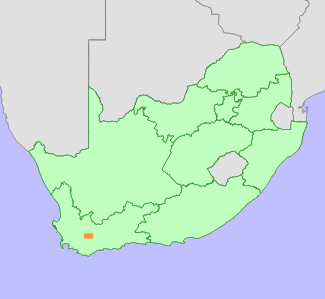|
Scientific Name | Lachnaea oliverorum Beyers |
Higher Classification | Dicotyledons |
Family | THYMELAEACEAE |
National Status |
Status and Criteria | Vulnerable D2 |
Assessment Date | 2004/12/21 |
Assessor(s) | J.B.P. Beyers & J.E. Victor |
Justification | A slow growing reseeder that is potentially threatened by too frequent fire, known from two subpopulations occurring ± 18 km apart. |
Distribution |
Endemism | South African endemic |
Provincial distribution | Western Cape |
Range | Waboomsberg near Montagu. |
Habitat and Ecology |
Major system | Terrestrial |
Major habitats | North Langeberg Sandstone Fynbos |
Description | Montane fynbos, in sandy soils, 1200-1400 m. |
Threats |
| Habitat degradation |
Population |
Population trend | Stable |
Assessment History |
Taxon assessed |
Status and Criteria |
Citation/Red List version | | Lachnaea oliverorum Beyers | VU D2 | Raimondo et al. (2009) | | Lachnaea oliverorum Beyers | Vulnerable | Hilton-Taylor (1996) | |
Bibliography |
Beyers, J.B.P. 2001. The Cape genus Lachnaea (Thymeleaceae): a monograph. Strelitzia 11:1-115. National Botanical Institute, Pretora.
Goldblatt, P. and Manning, J.C. 2000. Cape Plants: A conspectus of the Cape Flora of South Africa. Strelitzia 9. National Botanical Institute, Cape Town.
Hilton-Taylor, C. 1996. Red data list of southern African plants. Strelitzia 4. South African National Botanical Institute, Pretoria.
Raimondo, D., von Staden, L., Foden, W., Victor, J.E., Helme, N.A., Turner, R.C., Kamundi, D.A. and Manyama, P.A. 2009. Red List of South African Plants. Strelitzia 25. South African National Biodiversity Institute, Pretoria.
|
Citation |
| Beyers, J.B.P. & Victor, J.E. 2004. Lachnaea oliverorum Beyers. National Assessment: Red List of South African Plants version 2024.1. Accessed on 2025/12/04 |
 Comment on this assessment
Comment on this assessment


